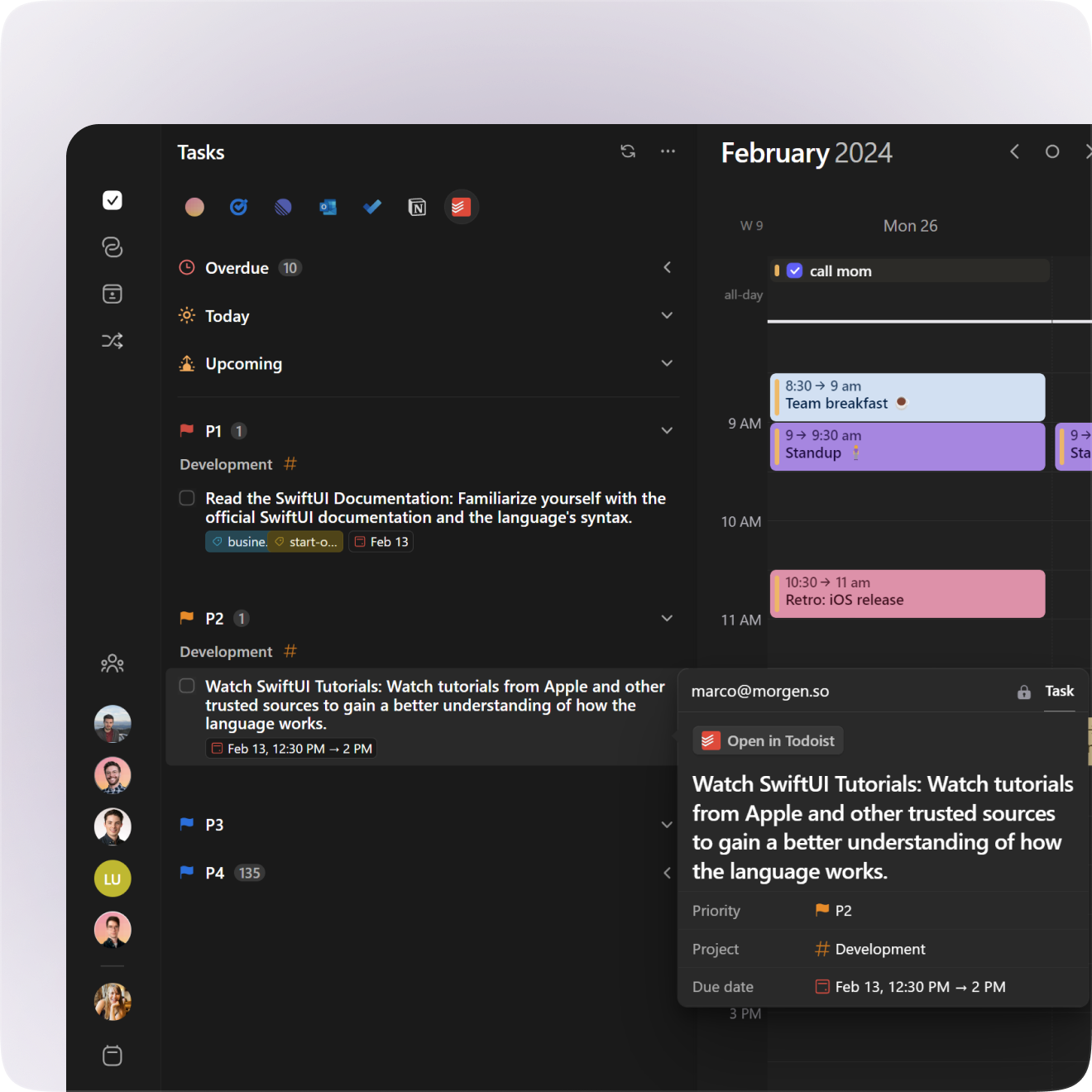Why use Todoist with Morgen
If you store your tasks in Todoist, the Morgen integration lets you plan time to complete those tasks and time block them in your calendar, so you’re not just tracking to-dos, you’re making time to finish them.
Key benefits
- Calendar-first execution: See tasks next to your schedule and plan realistically.
- Time blocking: Turn to-dos into protected calendar time (manually or with AI Planner).
- Always in sync: New tasks in Todoist show up in Morgen automatically.
- Confident follow-through: Ensure important work doesn’t get squeezed out by meetings.
Common use cases
- Individuals who manage tasks in Todoist but want a calendar-driven plan to complete them
- Teams using Todoist for task capture and Morgen for daily/weekly time blocking
- Anyone who wants AI-assisted scheduling for tasks, not just a list
- People who need flexible scheduling when priorities or meetings change
How to connect Morgen and Todoist
Connecting Todoist enables ongoing sync so your Todoist tasks appear in Morgen’s task panel.
Key steps
- Open Integrations in Morgen:
- Click your profile photo/initials (bottom left)
- Select Preferences
- Under Integrations, choose Task & projects
- Select Todoist
- Click Sign in with Todoist
- Complete the authentication prompt (quick sign-in)
Your Todoist tasks in Morgen
Once integrated, Todoist and Morgen stay in sync, tasks you add in Todoist will appear in Morgen’s task panel.
Key capabilities
- Browse by list: Click the Todoist logo in Morgen’s task manager to view tasks + subtasks organized by Todoist lists.
- See tasks alongside your calendar: Plan with full context.
- View task details: Open a task to see notes, priority, and due dates.
- Edit what syncs back: Most Todoist fields are locked in Morgen, but you can:
- Update task status
- Edit due dates (syncs back to Todoist)
- Smart date-based lists: You may see:
- Today, Upcoming (next week), Overdue
- These appear only when you have tasks in those windows
- You can disable Upcoming and/or Today from the task manager menu
Time blocking your Todoist tasks
This is where Todoist + Morgen really clicks: you convert tasks into scheduled work time.
Key capabilities
- AI Planner scheduling: Use the AI Planner to recommend when to work on tasks directly in your calendar (and optionally split large tasks into multiple work sessions).
- Manual scheduling: Drag a task from the task list into your calendar to create a time block.
- Resize and move blocks: Drag to extend/shrink, and shift blocks when plans change.
- Multiple work sessions (manual):
- Copy the scheduled task (Ctrl+C), click another time, paste (Ctrl+V)
- You can paste as many sessions as you want
- Note: the task is marked complete in Todoist only once the scheduled instances are completed
- Show scheduled tasks (optional):
- By default, scheduled tasks may disappear from the task list
- Turn on Show Scheduled Tasks in the task manager menu to keep everything visible
Completing your Todoist task
When you finish, completion stays consistent across both tools.
Key behaviors
- Check the open box in the scheduled task or in your task list
- The task is:
- Archived/removed from your Morgen task list
- Marked complete on your calendar if scheduled
- Marked complete in Todoist (synced)
Scheduling recurring Todoist tasks
Todoist and Morgen treat recurrence differently, so choose the approach based on how precise the timing needs to be.
Key options
- If you want multiple future instances visible/scheduled in Morgen:
- Don’t make it recurring in Todoist
- Create it as a normal task, schedule the first instance in Morgen
- Then set recurrence rules in Morgen so future instances appear on your calendar
- Best for precise patterns (e.g., “Sprint planning every second Friday afternoon”)
- If timing is flexible week-to-week:
- Keep it recurring in Todoist
- Schedule each instance as it appears
- Best for habits with adaptable timing (e.g., “Meditate once per week”)
.png)



